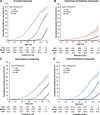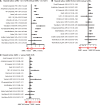Genotype and Lifetime Burden of Disease in Hypertrophic Cardiomyopathy: Insights from the Sarcomeric Human Cardiomyopathy Registry (SHaRe)
- PMID: 30297972
- PMCID: PMC6170149
- DOI: 10.1161/CIRCULATIONAHA.117.033200
Genotype and Lifetime Burden of Disease in Hypertrophic Cardiomyopathy: Insights from the Sarcomeric Human Cardiomyopathy Registry (SHaRe)
Abstract
Background: A better understanding of the factors that contribute to heterogeneous outcomes and lifetime disease burden in hypertrophic cardiomyopathy (HCM) is critically needed to improve patient management and outcomes. The Sarcomeric Human Cardiomyopathy Registry (SHaRe) was established to provide the scale of data required to address these issues, aggregating longitudinal datasets curated by eight international HCM specialty centers.
Methods: Data on 4591 HCM patients (2763 genotyped), followed for a mean of 5.4±6.9 years (24,791 patient-years; median [interquartile range] 2.9 [0.3-7.9] years) were analyzed regarding cardiac arrest, cardiac transplantation, appropriate implantable cardioverter-defibrillator (ICD) therapy, all-cause death, atrial fibrillation, stroke, New York Heart Association Functional Class III/IV symptoms (all comprising the overall composite endpoint), and left ventricular ejection fraction (LVEF)<35%. Outcomes were analyzed individually and as composite endpoints.
Results: Median age of diagnosis was 45.8 [30.9-58.1] years and 37% of patients were female. Age of diagnosis and sarcomere mutation status were predictive of outcomes. Patients <40 years old at diagnosis had a 77% [95% confidence interval: 72%, 80%] cumulative incidence of the overall composite outcome by age 60, compared to 32% [29%, 36%] by age 70 for patients diagnosed >60 years. Young HCM patients (20-29 years) had 4-fold higher mortality than the general United States population at a similar age. Patients with pathogenic/likely pathogenic sarcomere mutations had two-fold greater risk for adverse outcomes compared to patients without mutations; sarcomere variants of uncertain significance were associated with intermediate risk. Heart failure and atrial fibrillation were the most prevalent adverse events, although typically not emerging for several years after diagnosis. Ventricular arrhythmias occurred in 32% [23%, 40%] of patients <40 years at diagnosis, but in 1% [1%, 2%] >60 years.
Conclusions: The cumulative burden of HCM is substantial and dominated by heart failure and atrial fibrillation occurring many years following diagnosis. Young age of diagnosis and the presence of a sarcomere mutation are powerful predictors of adverse outcomes. These findings highlight the need for close surveillance throughout life, and the need to develop disease-modifying therapies.
Keywords: Genetics; Hypertrophic Cardiomyopathy; Natural history; Registry; Risk.
Figures




Comment in
-
Hypertrophic Cardiomyopathy.Circulation. 2018 Oct 2;138(14):1399-1401. doi: 10.1161/CIRCULATIONAHA.118.035932. Circulation. 2018. PMID: 30354358 No abstract available.
-
Response by Ho et al to Letter Regarding Article, "Genotype and Lifetime Burden of Disease in Hypertrophic Cardiomyopathy: Insights From the Sarcomeric Human Cardiomyopathy Registry (SHaRe)".Circulation. 2019 Mar 19;139(12):1559-1560. doi: 10.1161/CIRCULATIONAHA.118.039069. Circulation. 2019. PMID: 30883221 Free PMC article. No abstract available.
-
Letter by Maron et al Regarding Article, "Genotype and Lifetime Burden of Disease in Hypertrophic Cardiomyopathy: Insights From the Sarcomeric Human Cardiomyopathy Registry (SHaRe)".Circulation. 2019 Mar 19;139(12):1557-1558. doi: 10.1161/CIRCULATIONAHA.118.038189. Circulation. 2019. PMID: 30883223 No abstract available.
References
-
- Gersh BJ, Maron BJ, Bonow RO, Dearani JA, Fifer MA, Link MS, Naidu SS, Nishimura RA, Ommen SR, Rakowski H, Seidman CE, Towbin JA, Udelson JE, Yancy CW American College of Cardiology Foundation/American Heart Association Task Force on Practice Guidelines; American Association for Thoracic Surgery; American Society of Echocardiography; American Society of Nuclear Cardiology; Heart Failure Society of America; Heart Rhythm Society; Society for Cardiovascular Angiography and Interventions; Society of Thoracic Surgeons. 2011 ACCF/AHA guideline for the diagnosis and treatment of hypertrophic cardiomyopathy: executive summary: a report of the American College of Cardiology Foundation/American Heart Association Task Force on Practice Guidelines. Circulation. 2011;124:2761–2796. doi: 10.1161/CIR.0b013e318223e230. - PubMed
-
- Maron BJ, Rowin EJ, Casey SA, Maron MS. How hypertrophic cardiomyopathy became a contemporary treatable genetic disease with low mortality: shaped by 50 years of clinical research and practice. JAMA Cardiol. 2016;1:98–105. doi: 10.1001/jamacardio.2015.0354. - PubMed
-
- Richards S, Aziz N, Bale S, Bick D, Das S, Gastier-Foster J, Grody WW, Hegde M, Lyon E, Spector E, Voelkerding K, Rehm HL ACMG Laboratory Quality Assurance Committee. Standards and guidelines for the interpretation of sequence variants: a joint consensus recommendation of the American College of Medical Genetics and Genomics and the Association for Molecular Pathology. Genet Med. 2015;17:405–424. doi: 10.1038/gim.2015.30. - PMC - PubMed

